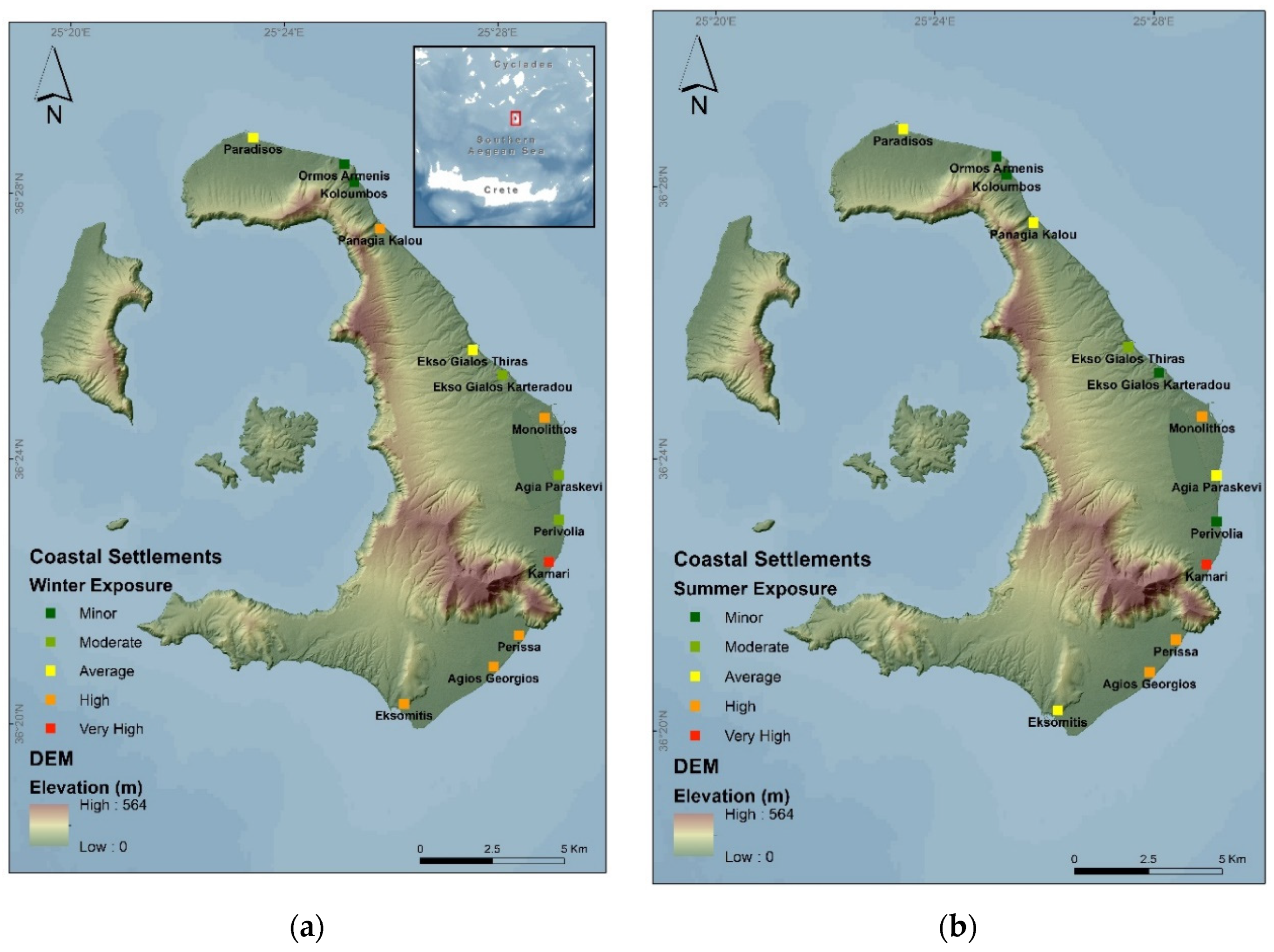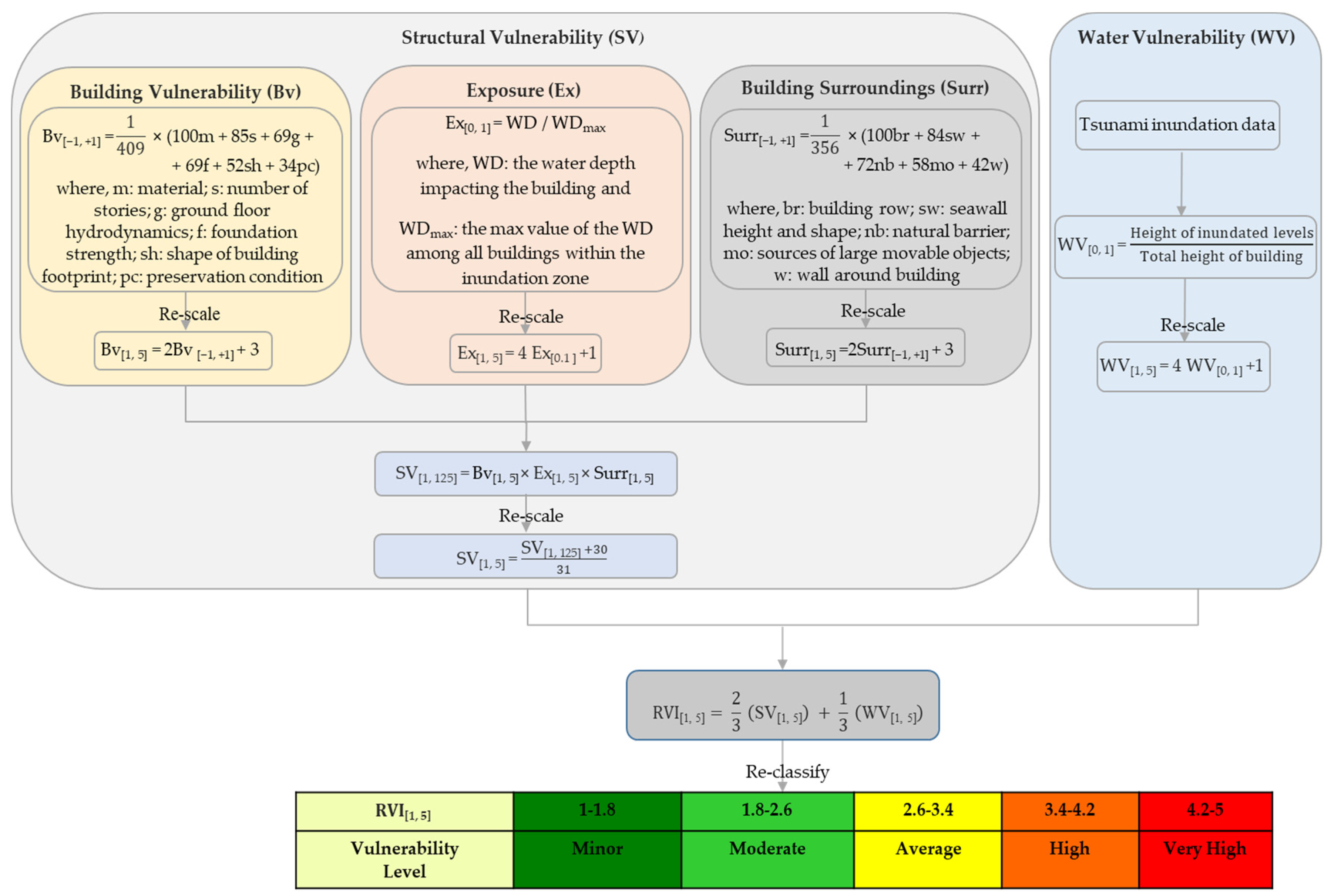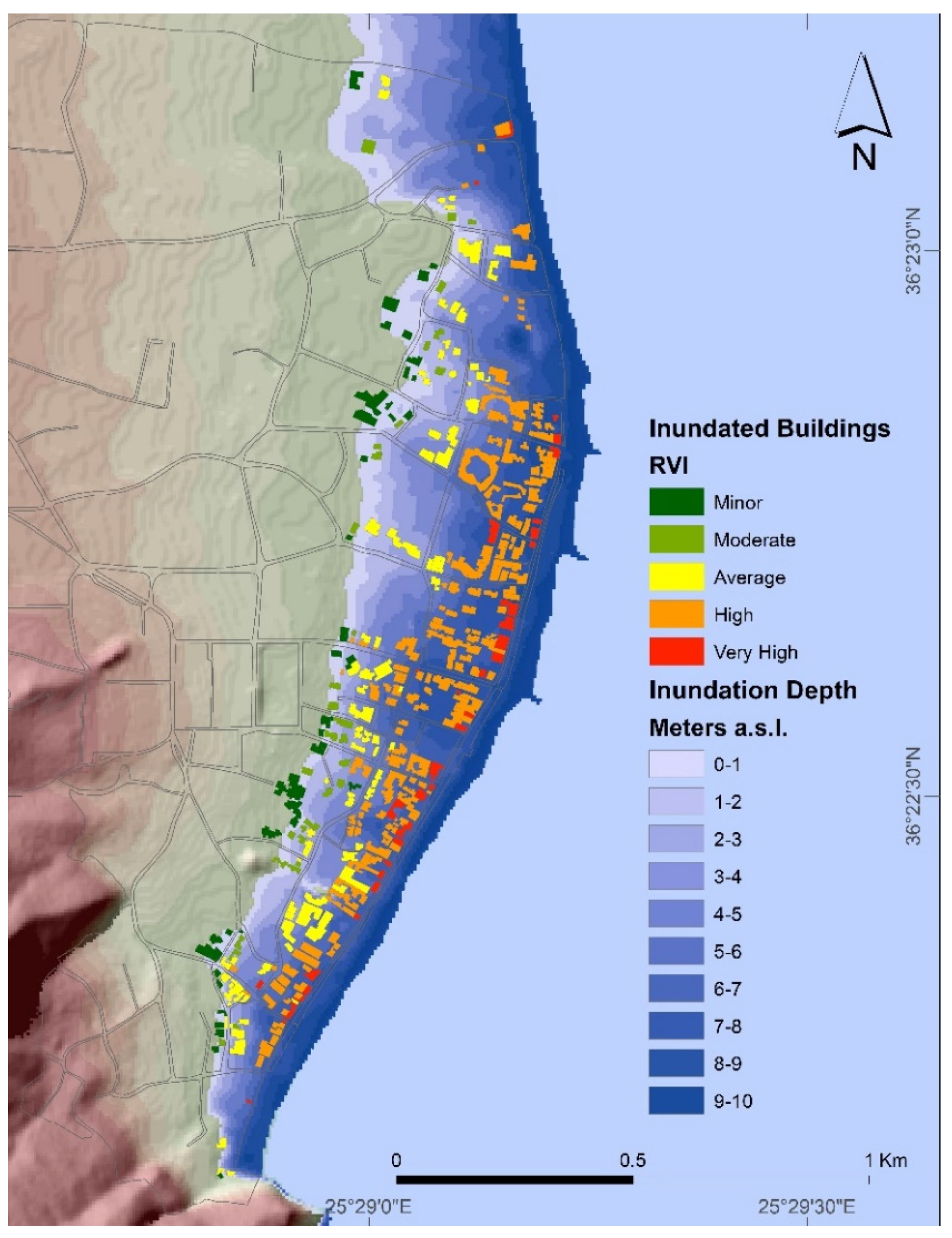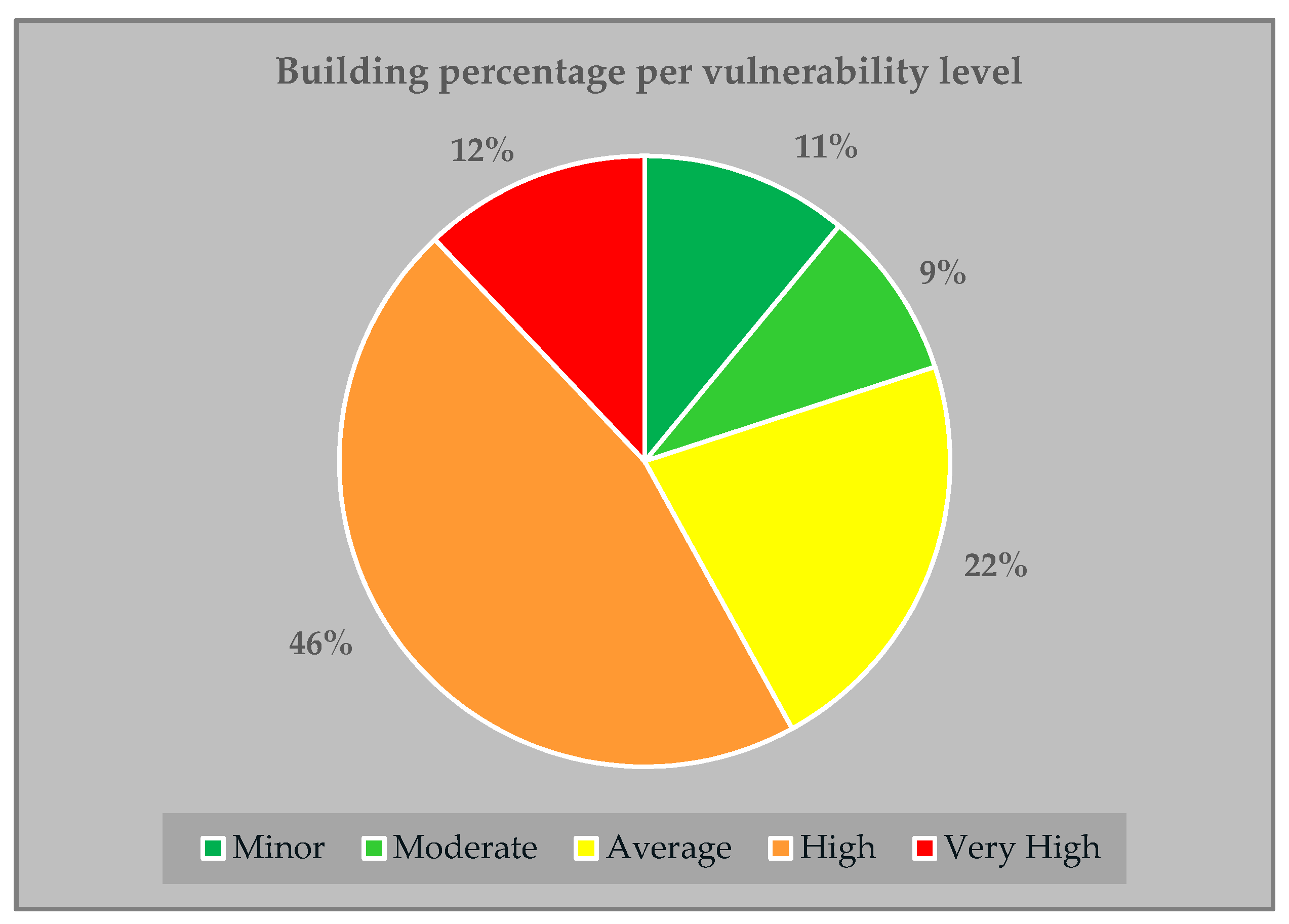Assessment of Building Vulnerability to Tsunami Hazard in Kamari (Santorini Island, Greece)
Abstract
:1. Introduction
2. Study Area
3. Materials and Methods
3.1. Coastal Settlements Exposure Analysis
3.2. Tsunami Run-up Scenario
3.3. Building Vulnerability Assessment
4. Results and Discussion
4.1. Structural and Water Vulnerability
4.2. Relative Vulnerability Index and Building Use
5. Conclusions
Author Contributions
Funding
Acknowledgments
Conflicts of Interest
References
- Witter, R.C.; Kelsey, H.M.; Hemphill-Haley, E. Great Cascadia earthquakes and tsunamis of the past 6700 years, Coquille River estuary, southern coastal Oregon. Geol. Soc. Am. Bull. 2003, 115, 1289–1306. [Google Scholar] [CrossRef]
- Cita, M.B.; Aloisi, G. Deep-sea tsunami deposits triggered by the explosion of Santorini (3500 y BP), eastern Mediterranean. Sediment. Geol. 2000, 135, 181–203. [Google Scholar] [CrossRef]
- Jiang, L.; LeBlond, P.H. Three-dimensional modeling of tsunami generation due to a submarine mudslide. J. Phys. Oceanogr. 1994, 24, 559–572. [Google Scholar] [CrossRef] [Green Version]
- Ambraseys, N.; Synolakis, C. Tsunami catalogs for the Eastern Mediterranean, revisited. J. Earthq. Eng. 2010, 14, 309–330. [Google Scholar] [CrossRef]
- Dominey-Howes, D.; Cundy, A.; Croudace, I. High energy marine flood deposits on Astypalaea Island, Greece: Possible evidence for the AD 1956 southern Aegean tsunami. Mar. Geol. 2000, 163, 303–315. [Google Scholar] [CrossRef]
- Bryant, E. Tsunami: The Underrated Hazard; Springer: Berlin/Heidelberg, Germany, 2014. [Google Scholar] [CrossRef]
- Papadopoulos, G.; Gràcia, E.; Urgeles, R.; Sallares, V.; De Martini, P.M.; Pantosti, D.; González, M.; Yalciner, A.C.; Mascle, J.; Sakellariou, D.; et al. Historical and pre-historical tsunamis in the Mediterranean and its connected seas: Geological signatures, generation mechanisms and coastal impacts. Mar. Geol. 2014, 354, 81–109. [Google Scholar] [CrossRef]
- Gauraz, A.L.; Valencia, N.; Koscielny, M.; Guillande, R.; Gardi, A.; Leone, F.; Salaun, T. Tsunami damages assessment: Vulnerability functions on buildings based on field and earth observation survey. Geophys. Res. Abstr. 2009, EGU2009-5785. [Google Scholar]
- Kelsey, H.M.; Witter, R.C.; Hemphill-Haley, E. Plate-boundary earthquakes and tsunamis of the past 5500 yr, Sixes River estuary, southern Oregon. Geol. Soc. Am. Bull. 2002, 114, 298–314. [Google Scholar] [CrossRef]
- Dominey-Howes, D. Assessment of tsunami magnitude and implications for urban hazard planning. Disaster Prev. Manag. 1998, 7, 176–182. [Google Scholar] [CrossRef]
- Dominey-Howes, D. Documentary and geological records of tsunamis in the Aegean Sea region of Greece and their potential value to risk assessment and disaster management. Nat. Hazards 2002, 25, 195–224. [Google Scholar] [CrossRef]
- Farreras, S.F. Post-tsunami field survey procedures: An outline. Nat. Hazards 2000, 21, 204–214. [Google Scholar] [CrossRef]
- Furlani, S.; Biolchi, S.; Devoto, S.; Saliba, D.; Scicchitano, G. Large boulder along the NE Maltese coast: Tsunami or storm wave deposits? J. Coastal Res. 2011, 61, 470. [Google Scholar] [CrossRef]
- Dominey-Howes, D. A re-analysis of the Late Bronze Age eruption and tsunami of Santorini, Greece, and the implications for the volcano–tsunami hazard. J. Volcanol. Geoth. Res. 2004, 130, 107–132. [Google Scholar] [CrossRef]
- Shiki, T.; Cita, M.B. Tsunami-related sedimentary properties of Mediterranean homogenites as an example of deep-sea tsunamiite. In Tsunamiites; Elsevier: Amsterdam, The Netherlands, 2008; pp. 203–215. [Google Scholar] [CrossRef]
- Willershäuser, T.; Vött, A.; Brückner, H.; Bareth, G.; Nelle, O.; Nadeau, M.J.; Hadler, H.; Ntageretzis, K. Holocene tsunami landfalls along the shores of the inner Gulf of Argostoli (Cefalonia Island, Greece). Zeitschrift für Geomorphol. 2013, 57, 105–138. [Google Scholar] [CrossRef]
- Papadopoulos, G. Tsunamis in the European-Mediterranean Region: From Historical Record to Risk Mitigation, 1st ed.; Elsevier: Amsterdam, The Netherlands, 2015. [Google Scholar]
- Tsanakas, K.; Karymbalis, E.; Cundy, A.; Gaki-Papanastassiou, K.; Papanastassiou, D.; Drinia, H.; Koskeridou, E.; Maroukian, H. Late Holocene geomorphic evolution of the Livadi coastl plain, Gulf of Argostoli, Cephalonia Island, Western Greece. Geogr. Fis. Din. Quat. 2019, 42, 45–61. [Google Scholar] [CrossRef]
- Cantalamessa, G.; Di Celma, C. Sedimentary features of tsunami backwash deposits in a shallow marine Miocene setting, Mejillones Peninsula, northern Chile. Sediment. Geol. 2005, 178, 259–273. [Google Scholar] [CrossRef]
- McCoy, F.W.; Heiken, G. Tsunami generated by the Late Bronze age eruption of Thera (Santorini), Greece. Pure Appl. Geophys. 2000, 157, 1227–1256. [Google Scholar] [CrossRef]
- Maramai, A.; Brizuela, B.; Graziani, L. The euro-mediterranean tsunami catalogue. Ann. Geophys. 2014, 57, 4, s0435. [Google Scholar] [CrossRef]
- Papazachos, B.C.; Papazachou, C. The Earthquakes of Greece; Ziti Publ. Co.: Thessaloniki, Greece, 2003. [Google Scholar]
- Sørensen, M.B.; Spada, M.; Babeyko, A.; Wiemer, S.; Grünthal, G. Probabilistic tsunami hazard in the Mediterranean Sea. J. Geophys. Res. 2012, 117, 1–15. [Google Scholar] [CrossRef] [Green Version]
- Papadopoulos, G.A. Tsunami hazard in the Eastern Mediterranean: Strong earthquakes and tsunamis in the Corinth Gulf, Central Greece. Nat. Hazards 2003, 29, 437–464. [Google Scholar] [CrossRef]
- Papadopoulos, G.A. Tsunamis in the East Mediterranean: A catalogue for the area of Greece and adjacent seas. In Proceedings of the International Workshop on Tsunami Risk Assessment beyond 2000, Moscow, Russia, 14–16 June 2000; pp. 34–42. [Google Scholar]
- Hamouda, A.Z. Numerical computations of 1303 tsunamigenic propagation towards Alexandria, Egyptian Coast. J. African Earth Sci. 2006, 44, 37–44. [Google Scholar] [CrossRef]
- Stiros, S.C. The AD 365 Crete earthquake and possible seismic clustering during the fourth to sixth centuries AD in the Eastern Mediterranean: A review of historical and archaeological data. J. Struct. Geol. 2001, 23, 545–562. [Google Scholar] [CrossRef]
- Shaw, B.; Ambraseys, N.N.; England, P.C.; Floyd, M.A.; Gorman, G.J.; Higham, T.F.G.; Jackson, J.A.; Nocquet, J.M.; Pain, C.C.; Piggott, M.D. Eastern Mediterranean tectonics and tsunami hazard inferred from the AD 365 earthquake. Nat. Geosci. 2008, 1, 268–276. [Google Scholar] [CrossRef]
- Werner, V.; Baika, K.; Tzigounaki, A.; Reicherter, K.; Papanikolaou, I.; Emde, K.; Fischer, P.; Vött, A. Mid-Holocene tectonic geomorphology of northern Crete deduced from a coastal sedimentary archive near Rethymnon and a Late Bronze Age Santorini tsunamite candidate. Geomorphology 2019, 326, 167–189. [Google Scholar] [CrossRef]
- Dominey-Howes, D.; Dawson, A.; Smith, D. Late Holocene coastal tectonics at Falasarna, western Crete (Greece): A sedimentary contribution. In Coastal Tectonics; Special Publication, Stewart, I., Vita-Finzi, C., Eds.; Geological Society: London, UK, 1998; Volume 146, pp. 341–350. [Google Scholar] [CrossRef]
- Ambraseys, N.N. The seismic sea wave of 9 July 1956, in the Greek Archipelago. J. Geophys. Res. 1960, 65, 1257–1265. [Google Scholar] [CrossRef]
- Stiros, S.C.; Marangou, L.; Arnold, M. Quaternary uplift and tilting of Amorgos Island (southern Aegean) and the 1956 earthquake. Earth Planet. Sci. Lett. 1994, 128, 65–76. [Google Scholar] [CrossRef]
- Dominey-Howes, D.T.M. Sedimentary deposits associated with the July 9th 1956 Aegean Sea Tsunami. Phys. Chem. Earth 1996, 21, 51–55. [Google Scholar] [CrossRef]
- Minoura, K.; Imamura, F.; Kuran, U.; Nakamura, T.; Papadopoulos, G.A.; Takahashi, T.; Yalciner, A.C. Discovery of Minoan tsunami deposits. Geology 2000, 28, 59–62. [Google Scholar] [CrossRef] [Green Version]
- Dominey-Howes, D.T.M.; Papadopoulos, G.A.; Dawson, A.G. Geological and historical investigation of the 1650 Mt. Columbo (Thera Island) eruption and tsunami, Aegean Sea, Greece. Nat. Hazards 2000, 21, 83–96. [Google Scholar] [CrossRef]
- Dall’Osso, F.; Dominey-Howes, D.; Tarbotton, C.; Summerhayes, S.; Withycombe, G. Revision and improvement of the PTVA-3 model for assessing tsunami building vulnerability using “international expert judgment”: Introducing the PTVA-4 model. Nat. Hazards 2016, 83, 1229–1256. [Google Scholar] [CrossRef]
- Alexander, D. Confronting Catastrophe: New Perspectives on Natural Disasters; Oxford University Press: New York, NY, USA, 2000. [Google Scholar]
- Iida, K. A relation of earthquake energy to tsunami energy and the estimation of the vertical displacement in a tsunami source. J. Earth Sci. 1963, 11, 49–67. [Google Scholar]
- Bohnhoff, M.; Rische, M.; Meier, T.; Becker, D.; Stavrakakis, G.; Harjes, H.P. Microseismic activity in the Hellenic Volcanic Arc, Greece, with emphasis on the seismotectonic setting of the Santorini–Amorgos zone. Tectonophysics 2006, 423, 17–33. [Google Scholar] [CrossRef] [Green Version]
- Dimitriadis, I.; Karagianni, E.; Panagiotopoulos, D.; Papazachos, C.; Hatzidimitriou, P.; Bohnhoff, M.; Rische, M.; Meier, T. Seismicity and active tectonics at Coloumbo Reef (Aegean Sea, Greece): Monitoring an active volcano at Santorini Volcanic Center using a temporary seismic network. Tectonophysics 2009, 465, 136–149. [Google Scholar] [CrossRef] [Green Version]
- Fytikas, M.; Kolios, N.; Vougioukalakis, G. Post-Minoan volcanic activity of the Santorini volcano. Volcanic hazard and risk, forecasting possibilities, In Thera and the Aegean World III, Volume Two, Earth Sciences; Hardy, D.A., Keller, J., Galanopoulos, V.P., Flemming, N.C., Druitt, T.H., Eds.; The Thera Foundation: London, UK, 1990; pp. 183–198. [Google Scholar]
- Bailey, J.C.; Jensen, E.S.; Hansen, A.; Kann, A.D.J.; Kann, K. Formation of heterogeneous magmatic series beneath North Santorini, South Aegean island arc. Lithos 2009, 110, 20–36. [Google Scholar] [CrossRef]
- Sparks, R.S.J. The Santorini eruption and its consequences. Endeavour 1979, 3, 27–31. [Google Scholar] [CrossRef]
- Perissoratis, C. The Santorini volcanic complex and its relation to the stratigraphy and structure of the Aegean arc, Greece. Mar. Geol. 1995, 128, 37–58. [Google Scholar] [CrossRef]
- Stiros, S.C. The 8.5+ magnitude, AD365 earthquake in Crete: Coastal uplift, topography changes, archaeological and historical signature. Quat. Int. 2010, 216, 54–63. [Google Scholar] [CrossRef]
- ELSTAT (Hellenic Statistical Authority). 2011 Population-Housing Census; Hellenic Statistical Authority: Athens, Greece, 2014. [Google Scholar]
- ELSTAT (Hellenic Statistical Authority). 2011 Buildings Census; Hellenic Statistical Authority: Athens, Greece, 2015. [Google Scholar]
- Thywissen, K. Components of Risk: A Comparative Glossary; UNU-EHS: Bonn, Germany, 2006. [Google Scholar]
- Odeh, D.J. Natural hazards vulnerability assessment for statewide mitigation planning in Rhode Island. Nat. Hazards Rev. 2002, 3, 177–187. [Google Scholar] [CrossRef]
- Tanislav, D.; Costache, A.; Muratoreanu, G. Vulnerability to natural hazards in Romania. Forum Geogr. 2009, 8, 131–138. [Google Scholar]
- Tragaki, A.; Gallousi, C.; Karymbalis, E. Coastal hazard vulnerability assessment based on geomorphic, oceanographic and demographic parameters: The case of the Peloponnese (southern Greece). Land 2018, 7, 56. [Google Scholar] [CrossRef] [Green Version]
- Alberico, I.; Di Fiore, V.; Iavarone, R.; Petrosino, P.; Piemontese, L.; Tarallo, D.; Punzo, M.; Marsella, E. The tsunami vulnerability assessment of urban environments through freely available datasets: The case study of Napoli City (southern Italy). J. Mar. Sci. Eng. 2015, 3, 981–1005. [Google Scholar] [CrossRef] [Green Version]
- Fritis, E.; Izquierdo, T.; Abad, M. Assessing the tsunami building vulnerability PTVA-3 and PTVA-4 models after the 16S 2015 event in the cities of Coquimbo–La Serena (Chile). Nat. Hazards Earth Syst. Sci. 2018, 18, 1703–1716. [Google Scholar] [CrossRef]
- Harisuthan, S.; Hasalanka, H.; Kularatne, D.; Siriwardana, C. Applicability of the PTVA-4 model to evaluate the structural vulnerability of hospitals in Sri Lanka against tsunami. Int. J. Disaster Resil. Built Environ. 2020, 11, 581–596. [Google Scholar] [CrossRef]
- Papathoma, M. Assessing Tsunami Vulnerability Using GIS with Special Reference to Greece. Ph.D. Thesis, Coventry University, Coventry, UK, 2003. [Google Scholar]
- Dominey-Howes, D.; Papathoma, M. Validating a tsunami vulnerability assessment model (the PTVA model) using field data from the 2004 Indian Ocean tsunami. Nat. Hazards 2007, 40, 113–136. [Google Scholar] [CrossRef]
- Dall’Osso, F.; Gonella, M.; Gabbianelli, G.; Withycombe, G.; Dominey-Howes, D. A revised (PTVA) model for assessing the vulnerability of buildings to tsunami damage. Nat. Hazards Earth Syst. Sci. 2009, 9, 1557–1565. [Google Scholar] [CrossRef] [Green Version]
- Dall’Osso, F.; Gonella, M.; Gabbianelli, G.; Withycombe, G.; Dominey-Howes, D. Assessing the vulnerability of buildings to tsunami in Sydney. Nat. Hazards Earth Syst. Sci. 2009, 9, 2015–2026. [Google Scholar] [CrossRef] [Green Version]
- Tarbotton, C.; Dall’Osso, F.; Dominey-Howes, D.; Goff, J. The use of empirical vulnerability functions to assess the response of buildings to tsunami impact: Comparative review and summary of best practice. Earth Sci. Rev. 2015, 142, 120–134. [Google Scholar] [CrossRef]
- Bressan, L.; Guerrero, M.; Antonini, A.; Petruzzelli, V.; Archetti, R.; Lamberti, A.; Tinti, S. A laboratory experiment on the incipient motion of boulders by high-energy coastal flows. Earth Surf. Process Landf. 2018, 43, 2935–2947. [Google Scholar] [CrossRef] [Green Version]













| Inundation Depth (m) | Number of Buildings | Cumulative Frequency | Cumulative Frequency % |
|---|---|---|---|
| 9–10 | 0 | 0 | 0 |
| 8–9 | 33 | 33 | 7.8 |
| 7–8 | 88 | 121 | 28.6 |
| 6–7 | 80 | 201 | 47.5 |
| 5–6 | 40 | 241 | 57.0 |
| 4–5 | 33 | 274 | 64.8 |
| 3–4 | 28 | 302 | 71.4 |
| 2–3 | 37 | 339 | 80.1 |
| 1–2 | 35 | 374 | 88.4 |
| 0–1 | 49 | 423 | 100 |
| Single-use | |||||||
| Inundation depth (m) | Dwelling | Hotel | Restaurant | Retail | Religious | Storage | Unknown |
| 9–10 | 0 | 0 | 0 | 0 | 0 | 0 | 0 |
| 8–9 | 5 | 10 | 6 | 7 | 0 | 0 | 0 |
| 7–8 | 16 | 23 | 22 | 14 | 0 | 3 | 2 |
| 6–7 | 12 | 35 | 7 | 14 | 1 | 1 | 1 |
| 5–6 | 11 | 19 | 1 | 3 | 0 | 2 | 0 |
| 4–5 | 7 | 14 | 2 | 1 | 0 | 1 | 1 |
| 3–4 | 5 | 11 | 5 | 5 | 0 | 0 | 0 |
| 2–3 | 12 | 11 | 3 | 4 | 2 | 2 | 0 |
| 1–2 | 15 | 10 | 2 | 3 | 1 | 1 | 1 |
| 0–1 | 20 | 13 | 0 | 4 | 0 | 0 | 2 |
| Total | 103 | 146 | 48 | 55 | 4 | 10 | 7 |
| Mixed-use | |||||||
| Inundation depth (m) | Retail/Dwelling | Retail/Restaurant | Retail/Hotel | Restaurant/Dwelling | Restaurant/Hotel | Hotel/Dwelling | |
| 9–10 | 0 | 0 | 0 | 0 | 0 | 0 | |
| 8–9 | 0 | 0 | 1 | 0 | 4 | 0 | |
| 7–8 | 3 | 1 | 2 | 1 | 0 | 1 | |
| 6–7 | 5 | 1 | 0 | 1 | 2 | 0 | |
| 5–6 | 3 | 0 | 0 | 0 | 1 | 1 | |
| 4–5 | 4 | 0 | 2 | 0 | 0 | 0 | |
| 3–4 | 2 | 0 | 0 | 0 | 0 | 0 | |
| 2–3 | 0 | 1 | 0 | 1 | 0 | 1 | |
| 1–2 | 3 | 0 | 0 | 0 | 0 | 1 | |
| 0–1 | 4 | 1 | 1 | 1 | 0 | 1 | |
| Total | 24 | 4 | 6 | 4 | 7 | 5 | |
| Relative Vulnerability Index (RVI) | ||||||
|---|---|---|---|---|---|---|
| Number of Buildings per Use | Minor | Moderate | Average | High | Very High | |
| Single-use | ||||||
| Dwelling | 103 | 18 | 16 | 24 | 42 | 3 |
| Hotels | 146 | 13 | 14 | 37 | 80 | 2 |
| Restaurant | 48 | 0 | 0 | 6 | 18 | 24 |
| Retail | 55 | 4 | 0 | 11 | 21 | 19 |
| Religious | 4 | 1 | 0 | 2 | 1 | 0 |
| Storage | 10 | 1 | 0 | 2 | 4 | 3 |
| Unknown | 7 | 2 | 1 | 0 | 4 | 0 |
| Mixed-use | ||||||
| Retail/Dwelling | 24 | 5 | 2 | 7 | 10 | 0 |
| Retail/Restaurant | 4 | 1 | 1 | 0 | 2 | 0 |
| Retail/Hotel | 6 | 1 | 0 | 2 | 3 | 0 |
| Restaurant/Dwelling | 4 | 1 | 0 | 1 | 2 | 0 |
| Restaurant/Hotel | 7 | 0 | 0 | 0 | 7 | 0 |
| Hotel/Dwelling | 5 | 1 | 1 | 2 | 1 | 0 |
| Total | 423 | 48 | 35 | 94 | 195 | 51 |
Publisher’s Note: MDPI stays neutral with regard to jurisdictional claims in published maps and institutional affiliations. |
© 2020 by the authors. Licensee MDPI, Basel, Switzerland. This article is an open access article distributed under the terms and conditions of the Creative Commons Attribution (CC BY) license (http://creativecommons.org/licenses/by/4.0/).
Share and Cite
Batzakis, D.-V.; Misthos, L.-M.; Voulgaris, G.; Tsanakas, K.; Andreou, M.; Tsodoulos, I.; Karymbalis, E. Assessment of Building Vulnerability to Tsunami Hazard in Kamari (Santorini Island, Greece). J. Mar. Sci. Eng. 2020, 8, 886. https://doi.org/10.3390/jmse8110886
Batzakis D-V, Misthos L-M, Voulgaris G, Tsanakas K, Andreou M, Tsodoulos I, Karymbalis E. Assessment of Building Vulnerability to Tsunami Hazard in Kamari (Santorini Island, Greece). Journal of Marine Science and Engineering. 2020; 8(11):886. https://doi.org/10.3390/jmse8110886
Chicago/Turabian StyleBatzakis, Dimitrios-Vasileios, Loukas-Moysis Misthos, Gerasimos Voulgaris, Konstantinos Tsanakas, Maria Andreou, Ioannis Tsodoulos, and Efthimios Karymbalis. 2020. "Assessment of Building Vulnerability to Tsunami Hazard in Kamari (Santorini Island, Greece)" Journal of Marine Science and Engineering 8, no. 11: 886. https://doi.org/10.3390/jmse8110886
APA StyleBatzakis, D.-V., Misthos, L.-M., Voulgaris, G., Tsanakas, K., Andreou, M., Tsodoulos, I., & Karymbalis, E. (2020). Assessment of Building Vulnerability to Tsunami Hazard in Kamari (Santorini Island, Greece). Journal of Marine Science and Engineering, 8(11), 886. https://doi.org/10.3390/jmse8110886







